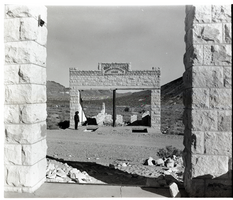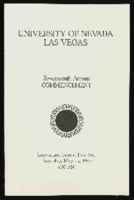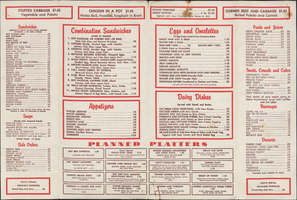Search the Special Collections and Archives Portal
Search Results
Muriel Parks oral history interview
Identifier
Abstract
Oral history interview with Muriel Parks conducted by Judy Drappo on February 26, 1979 for the Ralph Roske Oral History Project on Early Las Vegas. In this interview, Parks discusses her personal history and the history of the University of Nevada, Las Vegas (UNLV). Parks discusses her career working at UNLV as the Director of Admissions and Records, and how the university has changed over time. Parks also discusses the career of Maude Frazier and their personal relationship.
Archival Collection
Dr. Joseph Rojas oral history interview
Identifier
Abstract
Oral history interview with Dr. Joseph Rojas conducted by Suzanne Lubritz on February 25, 1980 for the Ralph Roske Oral History Project on Early Las Vegas. In this interview, Rojas describes his career as a gynecologist in Las Vegas, Nevada after being stationed at Nellis Air Force Base as chief of OBGYN during his time enlisted in the U.S. Air Force. Rojas also discusses how health care and medicine has evolved in Las Vegas, and Nevada as a whole.
Archival Collection
Nellis Air Force Base Installation Restoration Program Records
Identifier
Abstract
The collection, dated 1988-1999, was created by the United States Air Force, Nellis Air Force Base, Nevada. It consists of unclassified documents relating to the implementation of the Installation Restoration Program (IRP) of environmental remediation and restoration for Department of Defense (DOD) military installations, ranges, and disposal sites in Nevada.
Archival Collection
Karen Sarret Bartolo oral history interview
Identifier
Abstract
Oral history interview with Karen Sarret Bartolo conducted by Judy Harrell on November 25, 2013 for the West Charleston Neighborhoods--an Oral History Project of Ward 1. Bartolo recalls how it was growing up in Las Vegas, Nevada and her involvement with the Mormon Church. Bartolo then talks about her father's business, her starting a family and teaching for Clark County School District until retiring.
Archival Collection
Thomas McDonald oral history interview
Identifier
Abstract
Oral history interview with Thomas McDonald conducted by Ted Papatheodorou on July 05, 1975 for the Ralph Roske Oral History Project on Early Las Vegas. In this interview, McDonald describes his experiences running a newspaper and a restaurant in Chicago, Illinois before moving to Las Vegas, Nevada to work as a manager at the Stardust Hotel and Casino. McDonald shares several short anecdotes, such as being thrown off of a freight train in 1915 in early Las Vegas, or serving then-Senator Lyndon B. Johnson at his restaurant in Chicago.
Archival Collection
Geneva Stark Merwin oral history interview
Identifier
Abstract
Oral history interview with Geneva Stark Merwin conducted by Elizabeth Nelson Patrick on August 24, 1983 for the Ralph Roske Oral History Project on Early Las Vegas. In this interview, Merwin discusses her career and experiences as a teacher in Pahrump, Nevada after moving there in 1941. Merwin also discusses some of the people in the town and its layout. Merwin goes on to describe her teaching career in Las Vegas, Nevada after being recommended to the school board by Maude Frazier.
Archival Collection

Carole Fisher oral history interview: transcript
Date
Archival Collection
Description
Oral history interview with Carole Fisher conducted by Barbara Tabach on December 14, 2016 for the Southern Nevada Jewish Heritage Project. In this interview, Fisher discusses her family background and moving to Las Vegas, Nevada in 1979. Fisher talks about Nathan Adelson Hospice, programs that they provide for the Las Vegas senior community, and the increase of hospices in Las Vegas. She describes how Nathan Adelson Hospice is able to provide care for uninsured people, fundraising events they organize, and how their hospice differs from traditional hospital care. Lastly, Fisher discusses the significance of death in the Jewish religion.
Text

Film transparency of the ruins of the H. D. and L. D. Porter Brothers Store, Rhyolite, Nevada, November 25, 1948
Date
Archival Collection
Description
Image

University of Nevada, Las Vegas (UNLV) 17th commencement program
Date
Archival Collection
Description
Commencement program from University of Nevada, Las Vegas Commencement Programs and Graduation Lists (UA-00115).
Text

